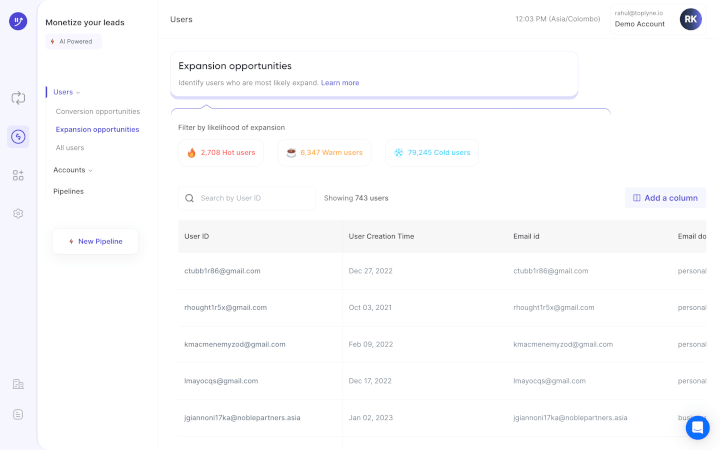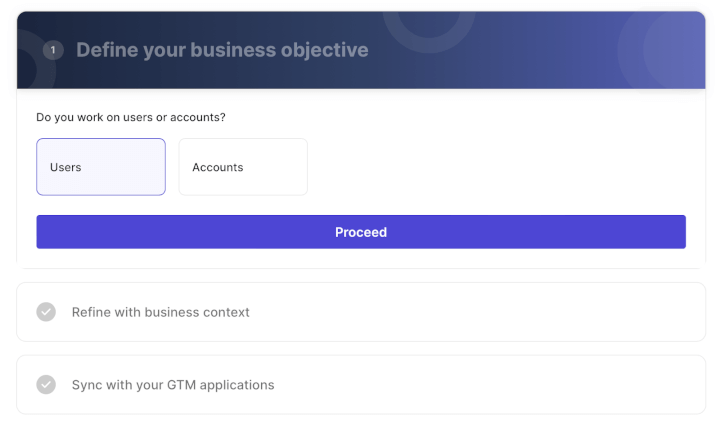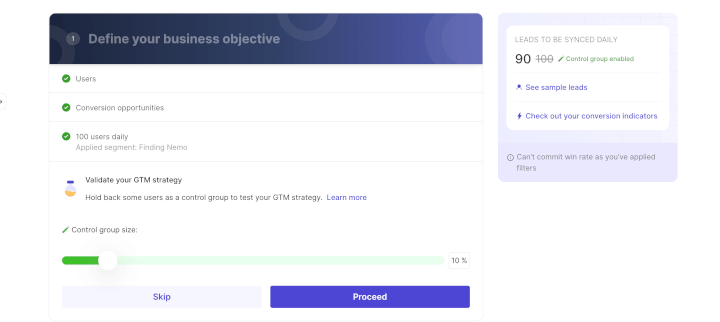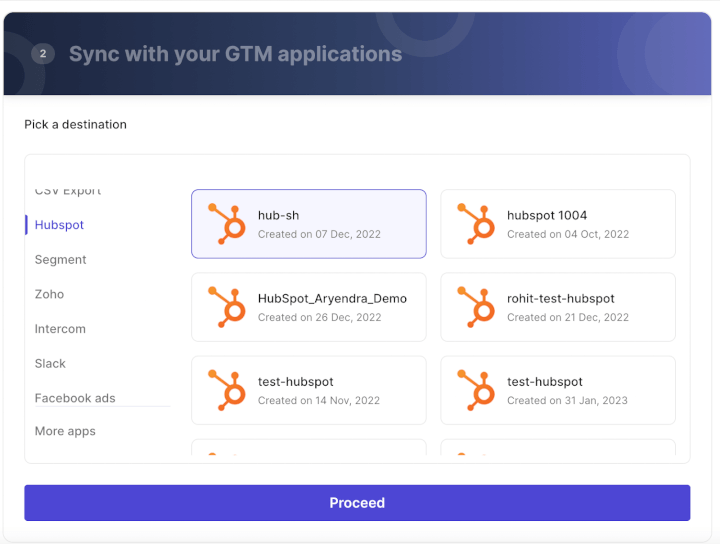The Ultimate Guide to Account Scoring (Examples + 5 Best Tips)

Lead scoring is how most SaaS companies find an ideal customer.
But how the heck do you score accounts?
There’s not just one lead — accounts involve multiple leads from the same company.
It’s kind of like Willy Wonka trying to find a successor for his chocolate factory.
So how do you decide who gets the golden ticket?

Let’s discover what account scoring and ABM (Account-Based Marketing) are, a few examples of account stakeholders, and what differentiates scoring accounts from lead scoring.
Also, explore improving your scoring criteria, a unique tool of pure imagination, and the advantages of scoring accounts.
What Is SaaS Account Scoring?
Scoring at an account level involves sorting all prospects from most valuable to least valuable. In other words, you see which accounts indicate the highest buying intent.
Your sales and marketing team will use a scoring model to qualify accounts by assigning value to certain actions or attributes, such as:
- Whether a prospect aligns with your Ideal Customer Profile (more on that later)
- Their level of interest or engagement
- Where they are in the buyer’s journey
Then you add up the scores from your target account list to see which is the ideal customer.
But how do you create an account scoring model?

Just kidding, we’ll explain.
Accounts consist of multiple people from the same company — so you can’t use a lead scoring system that ranks individuals (more on that later).
But much like traditional lead scoring, you can assign value to specific criteria via Excel spreadsheets. That means manually inputting user information and studying engagement for all accounts. 🥱
And SaaS companies want software solutions to speed up the account prioritization process.
So come with me, and you’ll be in a world of pure automation. ✨
Nowadays, predictive scoring can automatically calculate scores using an AI machine learning model powered by a data warehouse. A data warehouse is a central knowledge base comprising firmographic, internal, and publicly available company information.
For instance, Toplyne’s ingenious headless AI lets you account score without change management. This simplified approach is essential for account based marketing.
What’s that, you ask?
Let’s discuss this.
What Is ABM (Account Based Marketing)?
ABM concentrates the efforts and resources of your revenue teams (people from your sales and marketing teams) on a target account.
You acquire prospects through demand gen (demand generation) strategies. Demand gen involves creating awareness and interest in your product via emails, social media posts, ad campaigns, and more.
A B2B marketer can’t manually track engagement so that a marketing automation platform can cut down monotonous work. Enhancing ABM with marketing automation will help you spot and nurture a marketing qualified account in no time. You can then focus on conversion.
Buying decisions in the SaaS industry rarely rest on just one person. That’s why ABM considers a target account list of each stakeholder, their role, intent, and how much sway each one has over the buying decision.
Such a comprehensive strategy helps your revenue teams collaborate more effectively.
The marketing team will know who to target and nurture with a personalized, relevant advertisement. Meanwhile, a sales rep can target specific stakeholders with conversion-focused pitches.
With such high-stake deals on the line, knowing who you’re working with is important.
So let’s break down the different types of stakeholders.
3 Examples of Crucial Account Stakeholders
Put simply, stakeholders are the main groups or people — both inside and outside your company — that have a vested interest in your product. There are three main types:
1. Authorities
Some stakeholders aren’t directly involved but still have significant sway over product-led projects. For example, shareholders, company owners, or legal and regulatory organizations.
And the decision maker — the key stakeholder that makes the final call and approves the purchase.
Getting an authority stakeholder’s input early on in product development is vital if you want to avoid them going —

2. End users
End users are the stakeholders who actually use your product. Because they’re the ones who have the most direct experience, their buying intent is crucial to the success of your product. You’ll typically find three types of end users:
- Beneficiaries: These are the group of people who derive value from your product. Unlike direct users, it’s less about the process of your product and more about results. They want to know how the product actively solves their problem.
- Direct users: These stakeholders have hands-on experience with the software. Their input revolves around assessing how your product makes their job easier, fits into current workflows, or solves a significant problem.
- Secondary users: Secondary users are in contact with direct end-users or only occasionally use the product themselves. Although they don’t take center stage, it’s important to accommodate this group since they work so closely with direct users.
3. Product Build Team
The product build team is the group of people within your company working toward a common goal on a product. They’re responsible for communicating with the client, establishing and achieving product goals, and hitting time and budget targets.
Each member of the product team has a different role:
- Product managers: Managers have the final say on scope, timeline, and budget. Their goal is to ensure day-to-day operations run smoothly so you can deliver a rock-solid product to a happy customer.
- Company liaisons: These are company representatives that manage communications between different parties, such as the company and client or departments within a company.
- Product developers: As the people who build your product, developers are important stakeholders. Their technical expertise is essential for communicating with clients on what features they can reasonably implement within a certain timeframe.
- Partners: Partners are usually outside groups but are still involved in the actual development process. They might own third-party tools or be business partners with the client and are responsible for ensuring your software is compatible with their systems.
You can further divide team members into external vs. internal stakeholders. Here’s the difference between them:
Internal stakeholders directly relate to your company (i.e., investment, employment, or ownership). They’re the most invested in the success of your organization.
External stakeholders don’t work directly with your company, but the product outcome still affects them somehow (i.e., customers, legal bodies, or regulatory organizations). Their focus is benefiting from the product with the least risk to their operations.
While both parties might seem at odds, the overall purpose is the same. All stakeholders must collaborate to ensure the results are like a lifetime supply of chocolate for everyone involved 🍫.
But with various stakeholders, you can’t just use a lead scoring model.
Why not?
Let’s get into this.
Account Score vs. Lead Score: What’s the Difference?
With lead scoring, you classify an individual contact as a qualified lead if they indicate buying intent. An account-based scoring model focuses on an entire company’s likelihood of becoming a paying customer.
It’s the difference between a single chocolate bar and a box of chocolates. And sometimes, boxes of chocolates are packed full of surprises!
Within the company are multiple stakeholders, all with different priorities and levels of interest. This can make the B2B buyer’s journey way more complex and non-linear.
Even a machine learning model with predictive scoring and marketing automation can lead to confusion if it’s only a lead scoring system.
For example, your sales team might contact more than one qualified lead without realizing they’re from the same organization. This makes aggregating account scores difficult.
Or your marketing team might not know which lead is the decision-maker and focus on the wrong lead with the wrong approach, resulting in a lost opportunity.
So adapting your traditional lead scoring criteria to include accounts is essential.
Account Scoring Comes with a Choco-Lot of Benefits
With an account-led scoring model, you can:
- Improve resource allocation: SaaS account scoring enables companies to easily identify high value accounts, so a sales rep can avoid wasting time and resources on bad-fit prospects.
- Increase customer acquisition and revenue: By scoring prospects, revenue teams can tailor sales activity to the needs and preferences of a target account. This improves the chances of conversions, which boosts your revenue.
- Improve customer satisfaction and retention: Identifying a promising prospect is like finding an everlasting gobstopper. Best-fit customers are far likelier to benefit from your products, resulting in happy customers and reduced churn.
Overall, account-based scoring criteria help SaaS companies improve their sales activity and marketing efforts, target high value accounts, and ultimately increase revenue and business growth.
Without a scoring model to help with account prioritization, your revenue teams might feel like…

So what’s the solution?
Let’s go through how to perfect your account scoring model.
How to Score Accounts with Precision
Let’s dive into five ways you can score at an account level with success:
1. Identify Your ICP (Ideal Customer Profile)
ICPs are customers that are well suited to buy your offering.
Targeting irrelevant customers leads to more churn and a lower chance of subscription renewals.
After your demand gen efforts gather a pool of prospects and customers, start identifying patterns in their characteristics and behaviors via intent data. You should also consider their company size, location, and pain points.
Every data point you collect about a prospect can help you target them with a timely, relevant advertisement.
Going after ICPs with a relevant advertisement increases the chances of long-term retention, upsells, cross-sells, and more profit.
2. Map Relationships
Scoring accounts with multiple leads is difficult. This is why you need a knowledge base to simplify the process — like a relationship map!
A relationship map visually represents an account, charting key decision-makers on both sides and their relationships.
Present each data point however you wish — in the form of an account list, box plot, or bubble chart. Common practice includes displaying the name and role of each stakeholder and linking them together via arrows. Here’s a quick tip: It helps if you use color coding!
A visual map provides crucial context so your revenue teams understand who they should target and why.
3. Establish Your Scoring Criteria With Three Types of Data
There are three main data sets your account scoring model needs for lead qualification:
- Engagement data: This shows you which accounts are the most interested in your product. You measure engagement via first-party product analytics, billing, and CRM data.
- Firmographic data: This includes information on each data point relating to the account’s company, such as company size, annual revenue, vertical, or industry. Third-party enrichment tools like Clearbit and Apollo can do this for you.
- Technographic data: This is information about the company’s tech stack, such as what current tools they’re using and the impact they might have on the integration process (e.g. Salesforce).
Psst… Toplyne smoothly accommodates your tech stack, examining in-app actions to help you identify a qualified account with zero change management.
4. Get the Team Involved
Get salespeople involved in shaping your criteria. They can help decide which factors you consider in an account score and how much value you should assign to them.
A sales rep has experience with pushing prospects to convert. So they can provide more context and insight into what the minimum account score should be for a qualified account.
Then you can explain the process to the whole team and ensure everyone is on the same page.
5. Identify and Prioritize
So you’ve sorted out your ICP criteria, data warehouse, and relationship map and clarified everything with the team. By now, you should have enough information for account prioritization. This means you must identify the best-fit accounts to target in your ABM campaign.
As they say, the proof is in the pudding. It’s time to qualify accounts!
You can segment prospects into an account list of accounts that resemble your ideal customer profile.
Basically, you want to focus on a prospect that’s like —

— about your product!
But how do you create your target account list?
You should consider two factors:
- Which accounts have the potential to provide the most revenue?
- Which accounts have the highest tendency to buy?
This will help you to avoid wasting money on bad fits with expensive sales activity. For example, accounts with insufficient budgets or technology stacks that aren’t compatible with your software.
And you know what happens to bad-fit accounts?
They get stuck at the early stages of the sales funnel.
Wanna know how to make your pipeline smoother?
Use Toplyne to Surface a Pipeline of Qualified Accounts
The B2B buyer journey is more complex than it’s ever been before. Lead scoring isn’t enough anymore.
To keep your pipeline flowing like a river of chocolate, you need a machine learning model capable of scoring at a lead AND account level.
I bet you’re wondering… can such a perfect tool exist?
Yup, and its name is Toplyne! Let’s dive into what it does.

Toplyne’s astounding headless AI assists your efforts to create a smooth-running pipeline of qualified accounts.
It analyzes intent data from in-app usage patterns to identify opportunities for cross-selling or upselling. Then you’ll start seeing an increase in your net retention revenue (NRR) from your pool of high value accounts.
Here’s how companies like Canva and Vercel generate sales pipeline from their self-serve funnel using Toplyne:
- Step 1/7: Create monetization playbooks to surface conversion and expansion opportunities (leads most likely to convert to paying customers, and teams most likely to grow into larger teams)

- Step 2/7: Choose the right leads to target – users (individual users) or accounts (a group of users with an organization).

- Step 3/7: Select the frequency at which you would want leads synced in your GTM apps.

- Step 4/7: Define how many leads you want by either the number of leads or your expected win rate, depending on your sales capacity and GTM strategy.

- Step 5/7: Build custom segments - Build custom segments based on And/Or logic at the deepest level of sub-properties within your product analytics.

- Step 6/7: Validate your GTM strategy - Hold back some users as a control group to test your GTM strategy.

- Step 7/7: Sync your product qualified pipeline into your GTM destinations - CRMs, sales & marketing execution tools, and customer engagement platforms.

Spot a Top-Shelf Qualified Account Super Fast With Toplyne
Account scoring can get complicated fast. If your scoring model isn’t equipped to handle various stakeholders, you risk wasting resources and losing out on sale opportunities.
You can overcome these challenges if your approach considers the requirements of each stakeholder involved in the buyer’s journey.
But how do you simplify such an intricate process?
A tool like Toplyne can lead score AND support your sales team through an account buyer’s journey and build a powerful pipeline super fast.
Soon enough, you’ll get a taste of more delicious revenue 💰


.svg)









.png)